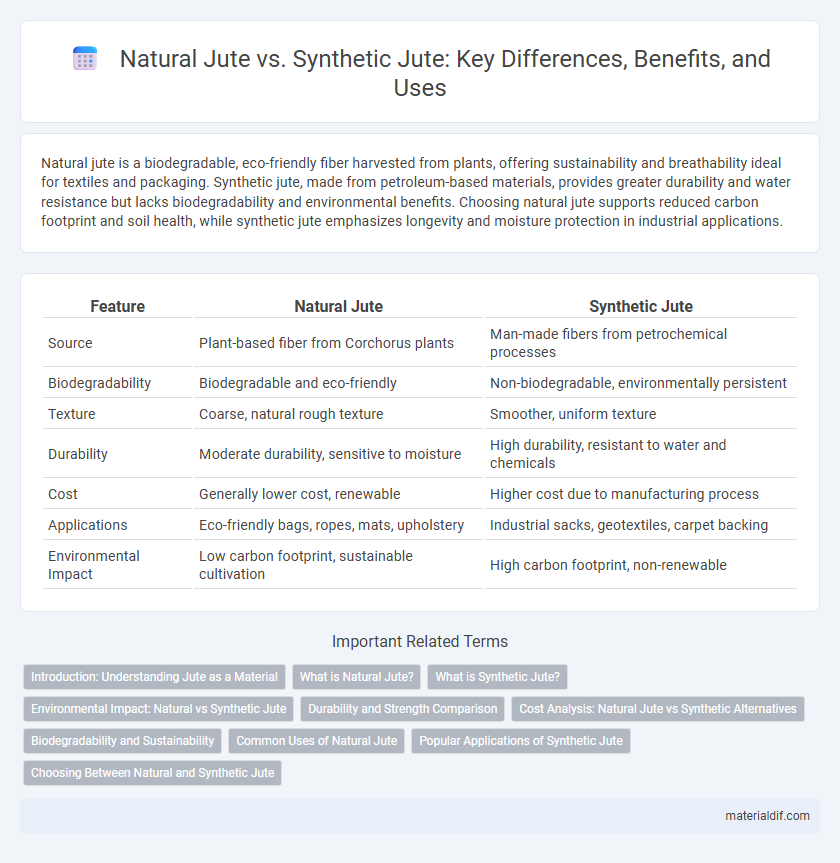Natural jute is a biodegradable, eco-friendly fiber harvested from plants, offering sustainability and breathability ideal for textiles and packaging. Synthetic jute, made from petroleum-based materials, provides greater durability and water resistance but lacks biodegradability and environmental benefits. Choosing natural jute supports reduced carbon footprint and soil health, while synthetic jute emphasizes longevity and moisture protection in industrial applications.
Table of Comparison
| Feature | Natural Jute | Synthetic Jute |
|---|---|---|
| Source | Plant-based fiber from Corchorus plants | Man-made fibers from petrochemical processes |
| Biodegradability | Biodegradable and eco-friendly | Non-biodegradable, environmentally persistent |
| Texture | Coarse, natural rough texture | Smoother, uniform texture |
| Durability | Moderate durability, sensitive to moisture | High durability, resistant to water and chemicals |
| Cost | Generally lower cost, renewable | Higher cost due to manufacturing process |
| Applications | Eco-friendly bags, ropes, mats, upholstery | Industrial sacks, geotextiles, carpet backing |
| Environmental Impact | Low carbon footprint, sustainable cultivation | High carbon footprint, non-renewable |
Introduction: Understanding Jute as a Material
Natural jute is a biodegradable fiber derived from the stem of the Corchorus plant, widely valued for its eco-friendly properties and durability. Synthetic jute, often made from polypropylene or other plastic-based materials, mimics the texture of natural jute but lacks biodegradability and environmental sustainability. Understanding the differences between natural and synthetic jute is essential for applications in textiles, packaging, and agriculture, where material performance and ecological impact are critical factors.
What is Natural Jute?
Natural jute is a biodegradable fiber derived from the stem of the Corchorus plant, primarily cultivated in India and Bangladesh. It boasts eco-friendly properties, including high tensile strength, breathability, and moisture resistance, making it ideal for sustainable packaging and textiles. Unlike synthetic jute, which is made from petroleum-based polymers, natural jute decomposes naturally, reducing environmental impact and supporting the circular economy.
What is Synthetic Jute?
Synthetic jute is a man-made fiber designed to mimic the appearance and texture of natural jute, often produced from polypropylene or other plastic polymers. It offers enhanced durability, resistance to moisture, and reduced biodegradability compared to natural jute. Commonly used in packaging, upholstery, and sacks, synthetic jute serves as a cost-effective alternative where longevity and water resistance are critical.
Environmental Impact: Natural vs Synthetic Jute
Natural jute is biodegradable, renewable, and requires fewer pesticides, significantly reducing soil and water pollution compared to synthetic jute made from petroleum-based materials. Synthetic jute contributes to microplastic pollution and has a higher carbon footprint due to energy-intensive manufacturing processes. Choosing natural jute supports sustainable agriculture and decreases environmental degradation associated with plastic waste.
Durability and Strength Comparison
Natural jute fibers exhibit moderate durability and tensile strength, making them suitable for biodegradable packaging and eco-friendly textiles but prone to degradation under prolonged moisture exposure. Synthetic jute, typically made from polypropylene or polyester, offers superior durability and higher tensile strength, resisting moisture, UV radiation, and chemical damage more effectively than natural jute. The strength-to-weight ratio of synthetic jute enhances its application in heavy-duty industrial uses, whereas natural jute remains favored for sustainable products despite its comparatively lower durability.
Cost Analysis: Natural Jute vs Synthetic Alternatives
Natural jute is typically more cost-effective than synthetic alternatives due to lower raw material and production costs, making it a preferred choice in eco-friendly packaging and textiles. Synthetic jute often incurs higher expenses because of petroleum-based inputs and energy-intensive manufacturing processes. Overall, the affordability of natural jute supports its widespread use in sustainable industries aiming to reduce environmental impact.
Biodegradability and Sustainability
Natural jute is highly biodegradable, decomposing within a few months and enriching soil health without leaving harmful residues, making it an eco-friendly choice for sustainable agriculture and packaging. Synthetic jute, made from petroleum-based polymers, resists natural decomposition and contributes to long-term environmental pollution due to its non-biodegradable nature. The sustainability advantage of natural jute lies in its renewable source and minimal ecological footprint compared to synthetic alternatives, which rely on finite fossil fuels and generate persistent plastic waste.
Common Uses of Natural Jute
Natural jute is predominantly used in the production of eco-friendly bags, such as shopping and tote bags, and in making carpets, rugs, and mats due to its strong, coarse texture. It is also widely utilized in agricultural applications like sacks for storing grains and vegetables, as well as in home furnishing items such as curtains and upholstery. The biodegradable nature and sustainability of natural jute make it preferred over synthetic jute for environmentally conscious products.
Popular Applications of Synthetic Jute
Synthetic jute, often made from polypropylene or polyester fibers, is widely used in industrial packaging, erosion control, and geotextiles due to its durability and resistance to moisture. Its application in agriculture includes crop protection and weed control mats that enhance soil stability and reduce chemical usage. Additionally, synthetic jute is favored in the production of reusable shopping bags and upholstery, combining cost-effectiveness with environmental benefits through recyclability.
Choosing Between Natural and Synthetic Jute
Natural jute is biodegradable, renewable, and offers superior breathability, making it ideal for eco-friendly packaging and textiles. Synthetic jute, typically made from polypropylene, provides higher durability and resistance to moisture and pests, suitable for long-term outdoor use. Choosing between natural and synthetic jute depends on prioritizing environmental sustainability or enhanced durability for specific applications.
Natural Jute vs Synthetic Jute Infographic

 materialdif.com
materialdif.com